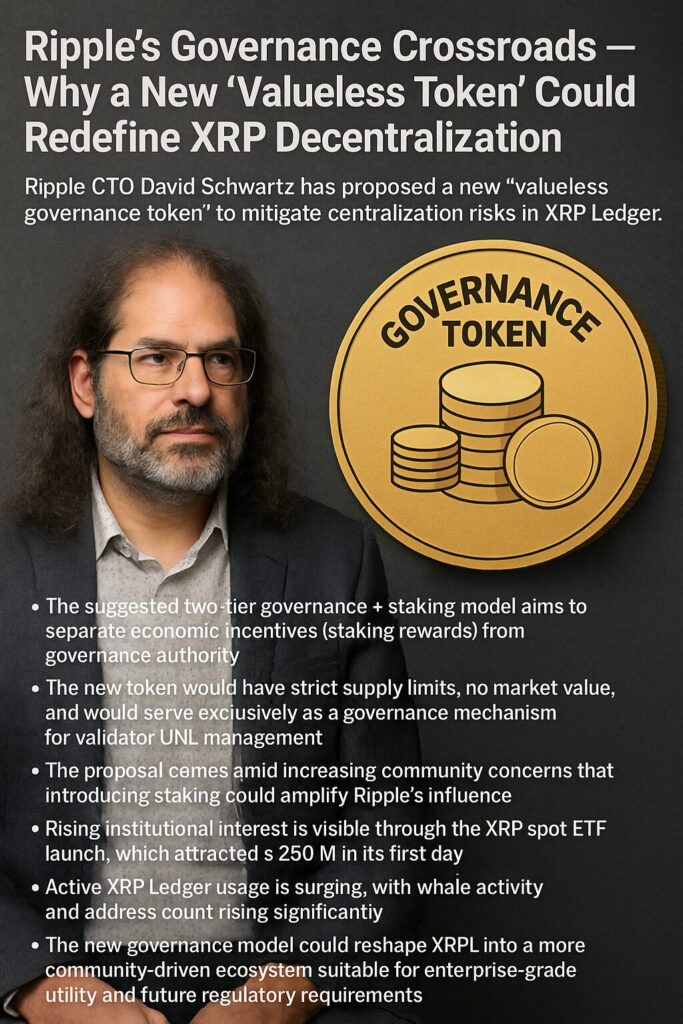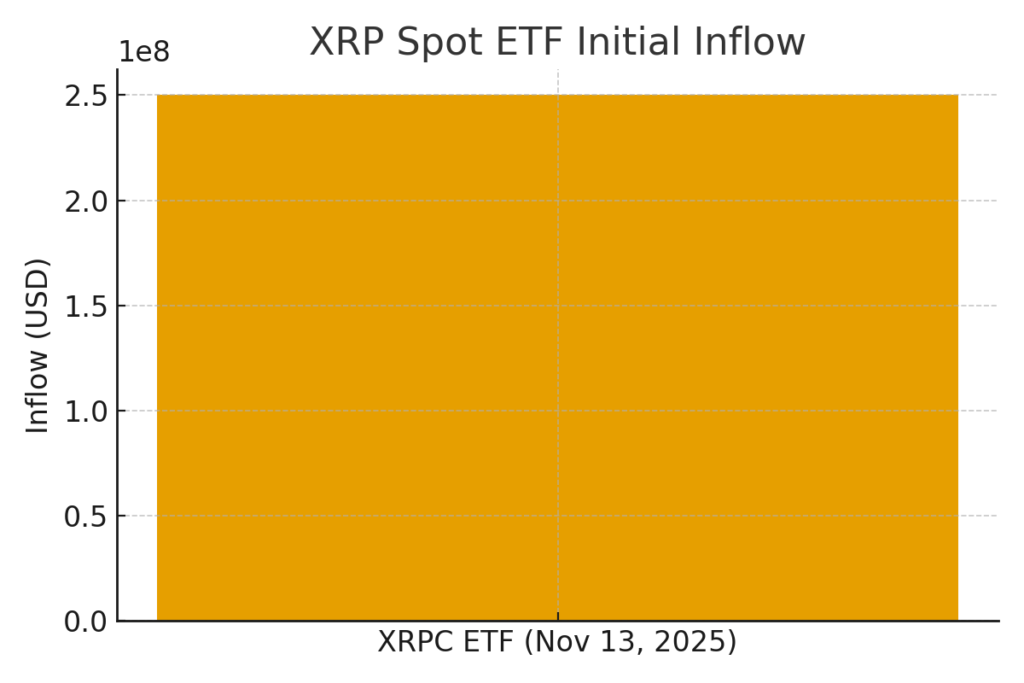
Main Points :
- Ripple CTO David Schwartz has proposed a new “valueless governance token” to mitigate centralization risks in the XRP Ledger.
- The suggested two-tier governance + staking model aims to separate economic incentives (staking rewards) from governance authority.
- The new token would have strict supply limits, no market value, and would serve exclusively as a governance mechanism for validator UNL management.
- The proposal comes amid increasing community concerns that introducing staking could amplify Ripple’s influence.
- Rising institutional interest is visible through the XRP spot ETF launch, which attracted $250M in its first day.
- Active XRP Ledger usage is surging, with whale activity and address count rising significantly.
- The new governance model could reshape XRPL into a more community-driven ecosystem suitable for enterprise-grade utility and future regulatory requirements.
1. Introduction — XRP at a Turning Point
In late 2025, Ripple CTO David Schwartz—the chief architect behind much of the XRP Ledger’s core logic—introduced a bold governance proposal that could reshape the future of XRPL. His suggestion: a new governance token, intentionally made economically worthless, designed purely to decentralize network oversight and reduce Ripple’s own influence.
The backdrop is clear. As XRP adoption increases, institutional staking models emerge, and the first U.S. XRP spot ETF begins trading, concerns grow that XRPL’s governance could become too tightly linked to Ripple’s large XRP holdings.
The proposed framework does not simply add a token. Instead, it aims to re-architect network governance, enabling validator autonomy, minimizing central-entity reliance, and preparing XRP for enterprise and global adoption.
2. The Background — Why the Community Is Worried About XRP Staking
2.1 Centralization Concerns from XRP Holders
For years, critics have argued that the XRP Ledger, while technically decentralized, is still heavily influenced by Ripple due to two factors:
- Ripple holds a large supply of XRP, which gives it disproportionate control if staking is added.
- The recommended UNL (Unique Node List) is published by Ripple, making many validators reliant on Ripple’s endorsement.
When discussions around “XRP staking” gained traction in 2025, community members quickly expressed concern:
- If staking rewards were introduced, Ripple could dominate due to its large holdings.
- Validators might only accept stakes from trusted partners, resulting in hidden gatekeeping and unintentional centralization.
- Bad actors might exploit staking pools unless strong governance exists.
Schwartz acknowledged these risks and agreed that a simple staking model could inadvertently centralize XRP.
This acknowledgment set the stage for his two-tier governance model.
3. Schwartz’s Proposal — A Two-Layer Governance Structure

3.1 Layer 1: XRP Staking (Economic Layer)
This layer includes the normal staking logic:
- Validators receive delegated stakes.
- Slashing is possible for malicious or inaccurate validation.
- Rewards distribute according to staking participation.
However, staking does NOT influence governance.
Schwartz warns that if economic and governance power merge, whales (including Ripple) could unintentionally gain disproportionate influence.
Thus, a new token is required.
3.2 Layer 2: “Valueless Governance Token” (Governance Layer)
This is the core of his proposal.
Key characteristics of the governance token:
| Feature | Description |
|---|---|
| Market Value | Intentionally zero — strict measures prevent speculation. |
| Supply | Extremely limited, fixed, and distributed only to verified community members or validators. |
| Use Case | Only for updating UNL lists and handling network governance votes. |
| Security Model | Helps decentralize control from Ripple. |
| Fork Protection | Enables “governance fork” if governance becomes corrupted. |
Schwartz envisions this token as a social governance primitive—not an asset.
It acts as a digital signature tool, allowing the community to collaboratively maintain a UNL without relying on Ripple or any single institution.
3.3 The “Governance Fork” Mechanism — A Nuclear Deterrent
One of Schwartz’s more innovative ideas is the “governance fork” capability.
If governance becomes compromised or manipulated:
- Validators can mint a fresh version of the governance token.
- The network can be cleanly forked.
- Bad actors lose influence.
- Honest consensus participants retain control.
Schwartz compared this to nuclear deterrence—a powerful tool meant not to be used, but to guarantee fair behavior.
This mechanism greatly increases community confidence that no single party, including Ripple, can dominate XRPL governance.
4. Community Response — Enthusiastic, Skeptical, and Everything in Between
Responses from developers, validators, and investors are polarized.
Supporters note:
- It finally solves the long-standing UNL centralization issue.
- It creates a governance layer independent of market speculation.
- It aligns with institutional expectations for transparent and auditable governance.
Critics argue:
- A valueless token still adds complexity.
- Some believe burn voting or existing mechanisms are sufficient.
- Others worry about token creation even if “valueless.”
Overall, the debate demonstrates that XRP governance is becoming a priority topic, especially as institutional staking and enterprise adoption increase.
5. Market Trends — XRPL Usage Surges Ahead of Governance Reform
5.1 Active Addresses Jump 7×
Recent network statistics show:
- XRPL active addresses increased sevenfold in the last quarter.
- Whale wallets continue accumulating XRP.
- XRPL DEX volume remains strong amid ETF interest.
This suggests real, organic usage—not just speculation.
5.2 XRP Spot ETF Launch: A Major Milestone

On November 13, 2025, Canary Capital’s spot XRP ETF “XRPC” debuted on U.S. markets.
First-day inflow:
- $250,000,000 USD
Below is the chart showing the inflow:
(Insert: xrp_etf_inflow.png)
This makes it one of the strongest ETF launches in crypto history.
Yet strangely, XRP’s price fell 8–9% immediately afterwards. Analysts attribute this to:
- Leveraged traders closing positions.
- Short-term profit-taking by early buyers.
- Market repositioning ahead of multiple upcoming ETFs.
5.3 More ETFs Are Coming
The story doesn’t end with Canary Capital.
Upcoming ETFs:
- Franklin Templeton (launching Nov 20)
- Bitwise
- 21Shares
If even two or three go live, industry analysts expect:
- Increased liquidity
- Improved institutional trust
- Potential price stabilization similar to post-BTC ETF dynamics
This increasing institutional participation intensifies the need for robust, decentralized governance—precisely why Schwartz’s proposal arrives at a critical moment.
6. Broader Context — How Governance Tokens Fit into Global Crypto Trends
Across the blockchain ecosystem, governance tokens have played both positive and negative roles. Issues such as plutocracy, whale voting, low participation, and token speculation plague many networks.
Schwartz’s “valueless governance token” model is a unique approach to:
- Avoid economic influence on governance
- Prevent whales from dominating
- Maintain decentralized validator lists
- Separate incentives from authority
This model may set a precedent for future enterprise-oriented chains, stablecoin networks, or financial-grade distributed ledgers.
7. How This Impacts Crypto Investors Seeking New Opportunities
Your target audience—investors and builders seeking new assets, yield opportunities, and practical blockchain utilities—may find this proposal particularly important.
Why?
Because a more decentralized XRPL could enable:
- Large-scale institutional staking without governance capture risks
- Enterprise-grade financial rails using XRP as settlement collateral
- Expanded utility for tokenized assets, CBDCs, and fiat-on-chain systems
- Safer, more transparent governance for developers and app builders
In short, XRP’s long-term technical credibility increases if governance is decentralized.
This, in turn, affects long-term valuation, adoption, and use-case expansion.
8. Conclusion — A Critical Evolution for XRPL
Ripple CTO David Schwartz’s proposal is more than a technical idea. It is a philosophical repositioning of the XRP Ledger.
The new governance token:
- Is not for speculation
- Is not for investment
- Is not another means of distributing value
It is a tool—a mechanism to guarantee decentralization when real financial stakes are at risk.
As XRPL transitions into an ecosystem increasingly used by banks, institutional investors, enterprises, and retail users, governance must evolve accordingly.
The XRP Ledger is at a crossroads:
- One path leads to stronger decentralization, institutional trust, and technical resilience.
- The other risks centralization, regulatory vulnerability, and stagnation.
Schwartz’s proposal may be the beginning of a new era—one where XRP becomes not just a fast settlement token, but an institution-grade decentralized financial infrastructure.

